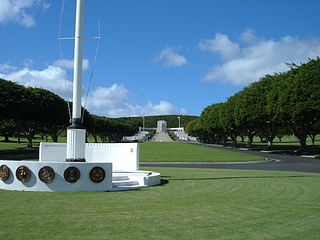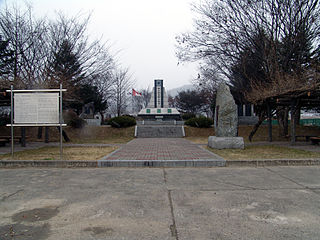North Korea

A number of memorials have been established to honour people who served in the Korean War (25 June 1950 – 27 July 1953) including :



Gyeonggi Province is the most populous province in South Korea.

Suwon is the largest city and capital of Gyeonggi Province, South Korea's most populous province. The city lies approximately 30 km (19 mi) south of the national capital, Seoul. With a population close to 1¼ million, Suwon has more inhabitants than Ulsan Metropolitan City, though it enjoys a lesser degree of self-governance as a 'special case city'.

The National Memorial Cemetery of the Pacific is a national cemetery located at Punchbowl Crater in Honolulu, Hawaii. It serves as a memorial to honor those men and women who served in the United States Armed Forces, and those who have been killed in doing so. It is administered by the National Cemetery Administration of the United States Department of Veterans Affairs and is listed on the National Register of Historic Places. Millions of visitors visit the cemetery each year, and it is one of the most popular tourist attractions in Hawaii.

Gapyeong County (Korean: 가평군) is a county in Gyeonggi Province, South Korea. It was the scene of the Battle of Kapyong, a major battle of the Korean War.

The Gloucester Hill Battle Monument or Gloucester Memorial is a memorial in South Korea that commemorates the actions of the Gloucestershire Regiment and C Troop, 170th Mortar Battery, Royal Artillery, of the British Army during the Battle of the Imjin River in 1951.
South Korea is made up of 22 first-tier administrative divisions: 6 metropolitan cities, 1 special city, 1 special self-governing city, and 14 provinces, including three special self-governing provinces and five claimed by the ROK government. These are further subdivided into a variety of smaller entities, including cities, counties, districts, towns, townships, neighborhoods and villages.

Paju is a city in Gyeonggi Province, South Korea. Paju was made a city in 1997; it had previously been a county (gun).

Cheonan is the largest and most densely populated city of Chungcheongnam-do, South Korea, and the third largest city in the Hoseo region after Daejeon and Cheongju. Cheonan borders Gyeonggi-do in the north, Chungcheongbuk-do to the east and southeast, Sejong City to the south and Asan-si and Gongju-si to the west and southwest.

The War Memorial of Korea (Korean: 전쟁기념관) is a museum located in Yongsan-dong, Yongsan-gu, Seoul, South Korea. It opened in 1994 on the former site of the army headquarters to exhibit and memorialize the military history of Korea. It was built for the purpose of preventing war through lessons from the Korean War and for the hoped for peaceful reunification of North and South Korea. The memorial building has six indoor exhibition rooms and an outdoor exhibition centre displaying war memorabilia and military equipment from China, South Korea and the United States.

The Seoul National Cemetery (Korean: 국립서울현충원) is located in Dongjak-dong, Dongjak District, Seoul, South Korea. The cemetery is reserved for Korean veterans, including those who died in the Korean independence movement, Korean War, and Vietnam War. Four South Korean presidents are buried in the cemetery.

In Seoul, public transit buses are operated by the Seoul Metropolitan Government and private bus operators.

The Gapyeong Canada Monument is a monument erected to commemorate the sacrifice of the Canadian Forces during the Korean War, especially at the Battle of Kapyong in the Canadian Korean War Memorial Garden. The English text describing the monument reads as follows:
Korean War Monument to the Canadian Armed Forces
This monument, located at 207-4 Igokri. Puk-myeon, Gapyeong-gun Gyeonggi-do Province, was erected by Gapyeong-gun, County on December 30, 1983 to replace an earlier monument erected by the U. N. Korean War Allies monument citizens of Gapyeong County in November 1975. The 6.5-meter monument rests on a 70-centimeter foundation in a 1,688 squaremeter site. The design of the monument is taken from the Canadian flag. It commemorates the victory of the Canadian troops in the Battle of Gapyeong on April 24 and 25, 1951.
When the Korean War began with a surprise attack on the South by Communist North Korea, Canada dispatched its forces to help defend the freedom of Korea and the peace of the world. The Canadian troops arrived in Korea in August 1950 and engaged in mopping up operations in the Samnyangjin area. They then moved north to fight in the Battle of Gapyeong and in other battles, advancing eight kilometers north of the 38th parallel. Securing a position at the confluence of the Han-gang and Imjim-gang Rivers, the Canadian troops occupied a high point north of Kaesong and conducted more than 1,000 reconnaissance operations.

Imjingak, and sometimes in English called the Imjingak resort, is a park located on the banks of the Imjin River along the tracks of the former Gyeongui Train Line outside the city of Paju, South Korea. The park has many statues and monuments regarding the Korean War. There is also a restaurant, an observation deck, a pool in the shape of the Korean peninsula, and even a small amusement park.

Suji-gu (Korean: 수지구), or Suji, is one of the three city districts in Yongin City, South Korea which is approximately 29 km south of Seoul. Suji became a city district on October 31, 2005, about nine years after Yongin officially became a city. When Yongin City was established in 1996, both urban and rural areas were covered to become a part of the city; thus to this day, Yongin's urbanization is varied throughout different regions of the city. Suji is one of the most urbanized areas of Yongin, as it borders Seongnam City's Bundang District and Suwon City, two more well developed areas. Home to the newly built Shinsegae Department Store and Dankook University in one of its towns, Jukjeon, Suji is rapidly developing as Yongin City becomes more and more urbanized. In recent years, the district has attracted upper-class Koreans, with the completion of the Samsung East Palace in 2010.
Confederate monuments and memorials in the United States include public displays and symbols of the Confederate States of America (CSA), Confederate leaders, or Confederate soldiers of the American Civil War. Many monuments and memorials have been or will be removed under great controversy. Part of the commemoration of the American Civil War, these symbols include monuments and statues, flags, holidays and other observances, and the names of schools, roads, parks, bridges, buildings, counties, cities, lakes, dams, military bases, and other public structures. In a December 2018 special report, Smithsonian Magazine stated, "over the past ten years, taxpayers have directed at least $40 million to Confederate monuments—statues, homes, parks, museums, libraries, and cemeteries—and to Confederate heritage organizations."

The United Nations Memorial Cemetery in Korea, located at Tanggok in the Nam District, City of Busan, Republic of Korea, is a burial ground for United Nations Command (UNC) casualties of the Korean War. It contains 2,300 graves and is the only United Nations cemetery in the world. Laid out over 14 hectares, the graves are set out in 22 sites designated by the nationalities of the buried servicemembers.
Pyeongtaek–Paju Expressway is an expressway in South Korea. It connects Pyeongtaek to Paju in Gyeonggi Province. The expressway's route number is 17, which it shares with the Iksan–Pyeongtaek Expressway. This expressway overlaps with the Capital Region Second Ring Expressway at Hwaseong.

Cemetery for North Korean and Chinese Soldiers located in Jajang-Ro, Papyeong-myeon (파평면), Paju, South Korea, is a burial ground for North Korean casualties of the Korean War and North Korean agents killed in South Korea since the end of the war. The cemetery formerly contained the remains of 437 Chinese People's Volunteer Army soldiers but these were all repatriated in March 2014.

The Daejeon National Cemetery (Korean: 국립대전현충원) is located in Hyeonchungwon-ro, Yuseong-gu, Daejeon, South Korea. It is South Korea's second national cemetery after the Seoul National Cemetery and is overseen by the Ministry of Patriots' and Veterans' Affairs.